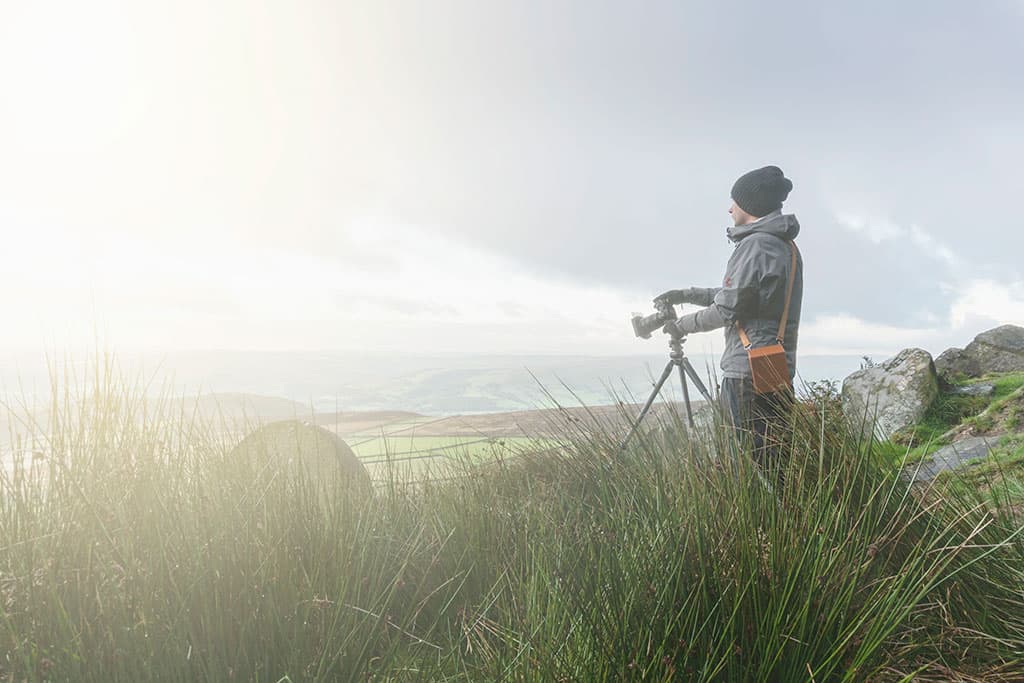The golden age of stock photography may be over but James Abbott investigates some alternative approaches to the traditional stock model that can be profitable
Stock photography has long played an important role in photographers’ revenue streams thanks to its ability to generate passive income from images. But where the stock industry was once lucrative to the point where some photographers could make a comfortable living from stock photography alone, this is unfortunately no longer the case.
Digital photography and the ability for almost anyone to sign-up to some stock libraries have flooded the market with images, which has in part driven down the royalties photographers receive; it’s a simple case of supply and demand.
But that’s not to say that the larger libraries such as Adobe Stock, Alamy, iStock, Getty, Shutterstock and many more are redundant since they can all provide that all-important passive income, albeit a modest one.
So, while you may not make a fortune from using one or more of these larger libraries to license your images, it’s still worth considering them because they can provide an additional revenue stream regardless of how profitable. You just have to consider the amount of work involved in preparing, uploading and keywording images against the potential income their sales will generate.
There are also other ways to license and sell your images, and that’s what we’re going to concentrate on here with four approaches to licensing and selling images in both digital and physical formats using alternative approaches to the traditional stock model.
The advantage of these is that you have control over pricing and the images you can sell, not to mention the opportunity to generate a much higher level of income from your photography.
Stock photography alternatives:
Picfair
Picfair is a stock photography disruptor that puts photographers of all levels in much greater control over image pricing when selling their images as either digital downloads or prints. All you have to do to get started is to sign up to the website, upload your images, set your price and you can then sell your images through your personal store on Picfair as well as through the Central Marketplace.
Setting up an account is incredibly easy, and you can opt for the free account, pay £69.90 for an annual subscription to Picfair Plus or sign-up for a monthly subscription for £7 per month.
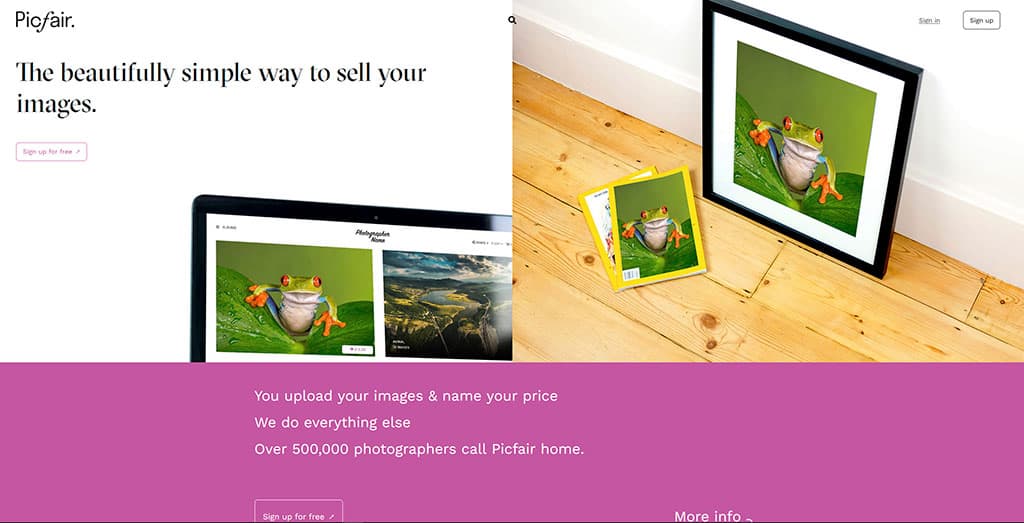
The free account is limited to 50 images with basic functionality that’s more than enough to get started, but if you’d like more control over the look and feel of your personal store, enjoy additional functionality, unlimited uploads, zero commission and much more, Picfair Plus is for you. You could always get started with the free account and upgrade once you’ve got to grips with the platform.
With this website, the photographer sets the price that they would like to receive for each image sold regardless of the account type they hold, while Picfair adds a 20% commission to this price for free accounts.
So, an image where the photographer has set the price to £20 will sell for £24, while no commission is added to Picfair Plus accounts so that image would sell for £20 or another price set by the photographer. Funds from sales will then be paid by BACS (UK only) or to your PayPal account – it’s really that simple.
Images can be purchased as digital downloads with licenses for editorial and personal uses, commercial uses and advertising uses. Each of these is on a sliding price scale with advertising usage providing the highest revenue for the photographer. Buyers can also purchase prints, framed prints and canvas wraps with fulfilment handled by Picfair so you can sit back and relax.
SmugMug
If you’d like full control over image sales, whether digital downloads or prints, framed prints and other traditional print options, SmugMug is a great option because it allows you to incorporate these selling options into your SmugMug website.
SmugMug is a website and hosting company whose e-commerce solutions are aimed primarily at professional photographers, which is reflected in the price for the two plans where this functionality is available.
To sell images as digital downloads with either a personal or commercial license, or to sell prints etc. you’ll need to sign-up for the Portfolio or Pro accounts; Portfolio costs $32 per month or $240 annually, while Pro costs $50 per month or $432 annually, which means you need to be selling a lot of images to make the investment worthwhile.
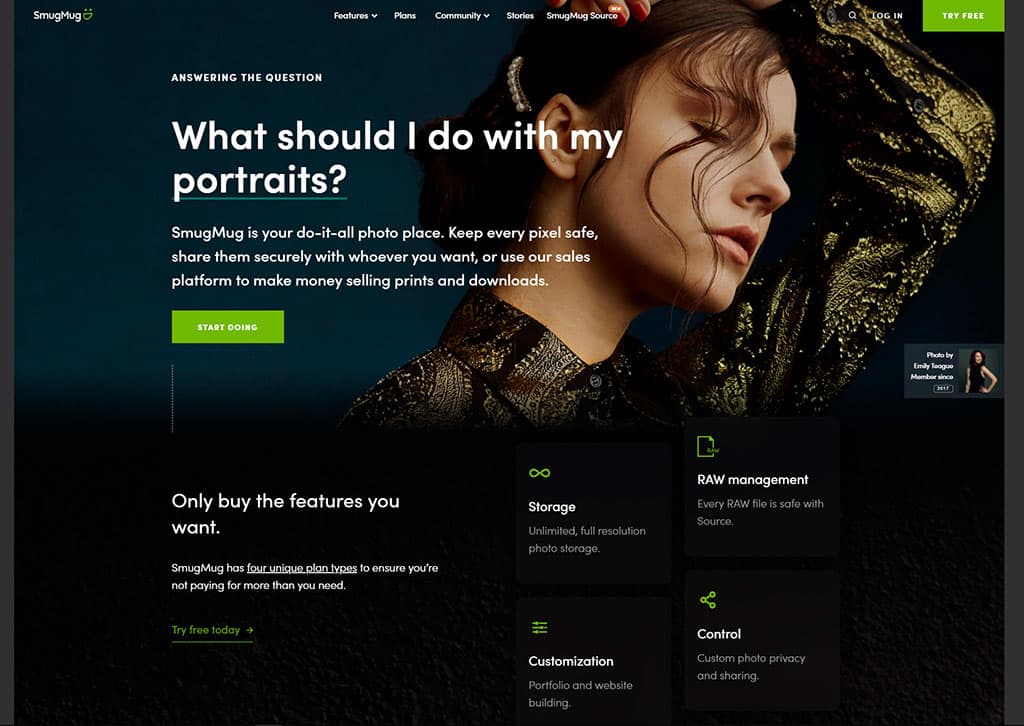
However, this does include your website and hosting, excluding your URL cost, so it may not be a great deal more expensive than the website service you already use or are considering.
When it comes to selling downloads, these are set up by you and the process is quite simple with plenty of guides available. Fees are attached to this service but they are low and can be viewed in the Help sections of the SmugMug website.
Selling prints is just as easy, with fulfilment in the UK and EU provided by Loxley Colour, with several other options available in the US. You can even order test prints to check the print quality of the different labs.
The SmugMug option is the ultimate in control because you host all sales within your own website and set your prices while SmugMug takes care of payment handling and print fulfilment through its reputable partner labs.
You receive 85% of the difference between your price and SmugMug’s default print prices with the 15% retained by SmugMug paying for credit card payment fees, customer service and administration.
Creative Market
Creative Market is one of the lesser-known options here and is primarily a website for selling digital design downloads such as graphics, fonts, design templates, Photoshop Actions and much more, with photo downloads and licensing being one of the options.
Physical print options are, however, not available because the emphasis here is digital downloads so it’s not as comprehensive as other options covered here.
With this website, you create a store, upload your images, set the prices and you’re now selling your images online. Creative Market then offers three licenses to buyers – Personal Only, Commercial and Extended Commercial with the ability for buyers to contact Creative Market for additional premium usage options.
These licenses provide a sliding scale of cost, with Extended Commercial being the most expensive if not counting premium usage where prices aren’t listed.
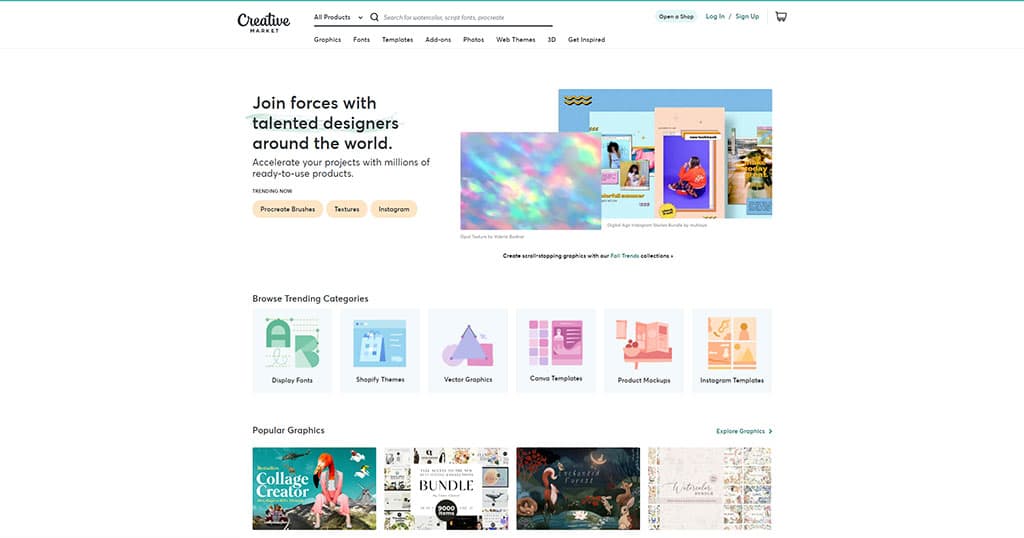
The beauty of this site is that it takes care of payments and sales tax for you, which can be a headache when selling digital products to EU countries because of the different rates of VAT in member states.
But since the website is based in the United States, you need to fill in a tax form to avoid paying unnecessary US taxes if based outside of the country and this can be done through the website itself. You are, of course, still liable for income tax in the UK and must declare your earnings as with all of the options we’ve covered here.
Payments are available to be requested once you’ve reached the minimum threshold of $20, and payments are made on a set date each month to your nominated PayPal account. Use of Creative Market is free, but each sale you make is subject to a 30% commission that goes to the website and is automatically deducted from your sales.
This can be offset against the amount you sell your images for, but prices here are generally lower than Picfair, for instance, so you wouldn’t want to make your prices too high to remain competitive.
Fine Art America
Throwing something of a curveball into the mix, Fine Art America is a website that’s primarily aimed at selling a wide range of physical products featuring your photos.
These range from traditional print options such as canvases and framed prints, to products such as bags and phone cases featuring your images – the full range of products is simply too large to list.
Plus, you can also license royalty-free and rights-managed digital downloads of your images, although the website is best known for its print-based offerings.
Creating an account, uploading your images and setting your profit on top of the production costs of the products is quick and easy, and with the free account you can upload up to 25 images.
The Premium Membership only costs $30 per year and provides unlimited uploads, the ability to sell your Fine Art America products on your website, provides a personal website if you don’t have one and you can send up to 10,000 marketing emails at a time. It’s a small price to pay for unlimited uploads and being able to copy and paste code into your existing website to sell products.
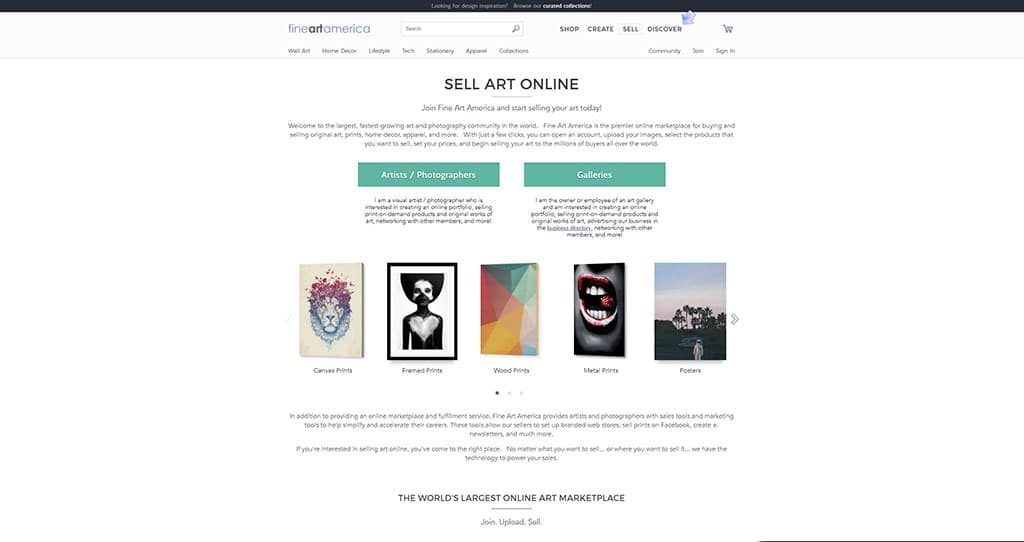
For physical products, Fine Art America has 16 manufacturing facilities in five countries around the world, meaning your work is accessible to the global market.
When it comes to digital downloads and licensing, you can set any of your images to be sold this way with the ability to sell royalty-free and rights-managed digital downloads, as well as being able to set up custom licenses for more specific uses with time limitations. For downloads, you set the price and Fine Art America adds a 30% commission on top.
The website is also a little like Flickr in that you can join groups, enter challenges and comment on other photographers’ images. So while it’s primarily a platform for selling photography products, there’s also a vibrant community that you can take part in.
Expert tips for maximising image sales

Philip Mowbray, content manager at Picfair (www.picfair.com) is an expert on all things stock photography and shares his top ten tips to help you to increase your chances of selling more images using online hosting services.
1. Don’t over-edit your photos
Keep editing to a minimum because buyers often apply their own adjustments to images to fit in-house styles. Any significant adjustments to a photo, especially those that render the image unrealistic, will restrict its use. So, when editing images for selling online, less is much more.
2. Leave space for text
Editorial customers often overlay text on images (eg. magazines and book covers) in areas such as sky, sea, grass or anywhere with a solid block of colour that isn’t too busy. Including space for text within your images will give them added value and ultimately much greater sales potential.
3. Self-promotion is essential
The landscape of image buying has changed dramatically over the past ten years and buyers often use social media to discover images. We find that photographers who are the most active on social media, linking and promoting their Picfair Stores, have increased success with selling their images.
4. Network with potential buyers
If a photographer’s work caters to a specific niche or industry, they should research and reach out to any relevant companies or contacts with a link to their images. This could be as simple as sending a quick email to an editor or manager to introduce themselves and their photography.
5. Accurately keyword images
Think like a buyer and include keywords that accurately describe the image and are likely to be used as search terms; an image might be an ideal fit for a buyer, but it needs the right keywords to be discoverable. Avoid using irrelevant keywords because this type of spamming annoys buyers.
6. Always include location information
Location information can have a significant influence on whether an image is purchased or not. Buyers often need clarity on where a photo was taken, especially for location-specific creative briefs and editorial features so providing this information is an effortless way to help your images sell.
7. Stand out from the crowd
Concentrate on developing a unique style and mastering a specific genre, rather than recreating the same generic images as other photographers. Photographers who stand out from the crowd with a more unique and identifiable style are generally more successful in the long run.
8. Follow upload requirements
Always follow the upload requirements of the hosting site. Any rules on what you can or cannot upload are there for a reason and ultimately to help you sell images and increase your chances of success. Attempting to bypass them will result in rejected images, disappointment and wasted time.
9. Sign up to email newsletters
Many photography blogs and image hosting sites will send regular emails to their photographer community; make sure you subscribe and absorb their advice. They’ll usually cover topics such as trends, what’s been popular on the platform and general tips for improving your images.
10. Take time to consider pricing
At Picfair, as with many other online hosting services, photographers are free to set their prices for their images. Prices vary, but we find that there’s a sweet spot between £10-£25 for an editorial/commercial licence or to purchase a print (excluding production and shipping).
Jargon buster
Rights managed
In stock photography, this is a licence that allows a single use of an image as outlined by the licence. The buyer can choose an exclusive licence which means additional licences won’t be sold within a set timeframe, but this is more expensive. Non-exclusive means that further licences can be sold.
Royalty-free
Royalty-free images are anything but free – the buyer still has to pay for a licence to use, but usage is much more open than rights managed. With this non-exclusive licence, that the image can be used multiple times for different uses for the initial price that’s paid for the licence.
Commercial use
Commercial use refers to images that are used to sell a product or service. These images require model and property releases, while logos, brand names and recognisable products should be avoided when shooting because these can be problematic and could lead to lost sales or hours of retouching.
Editorial use
Images depicting people or private property that don’t have model releases can be used editorially in magazines, newspapers and textbooks etc. to illustrate a story or idea, but they can’t be used commercially to sell a product or service, for instance.
Releases
For images depicting people or private property, you must have a model release or property release for images to be used commercially to sell a product or service. Even if you photograph a friend or family member with the intention of using the images commercially, you still need a model release.
Further reading



